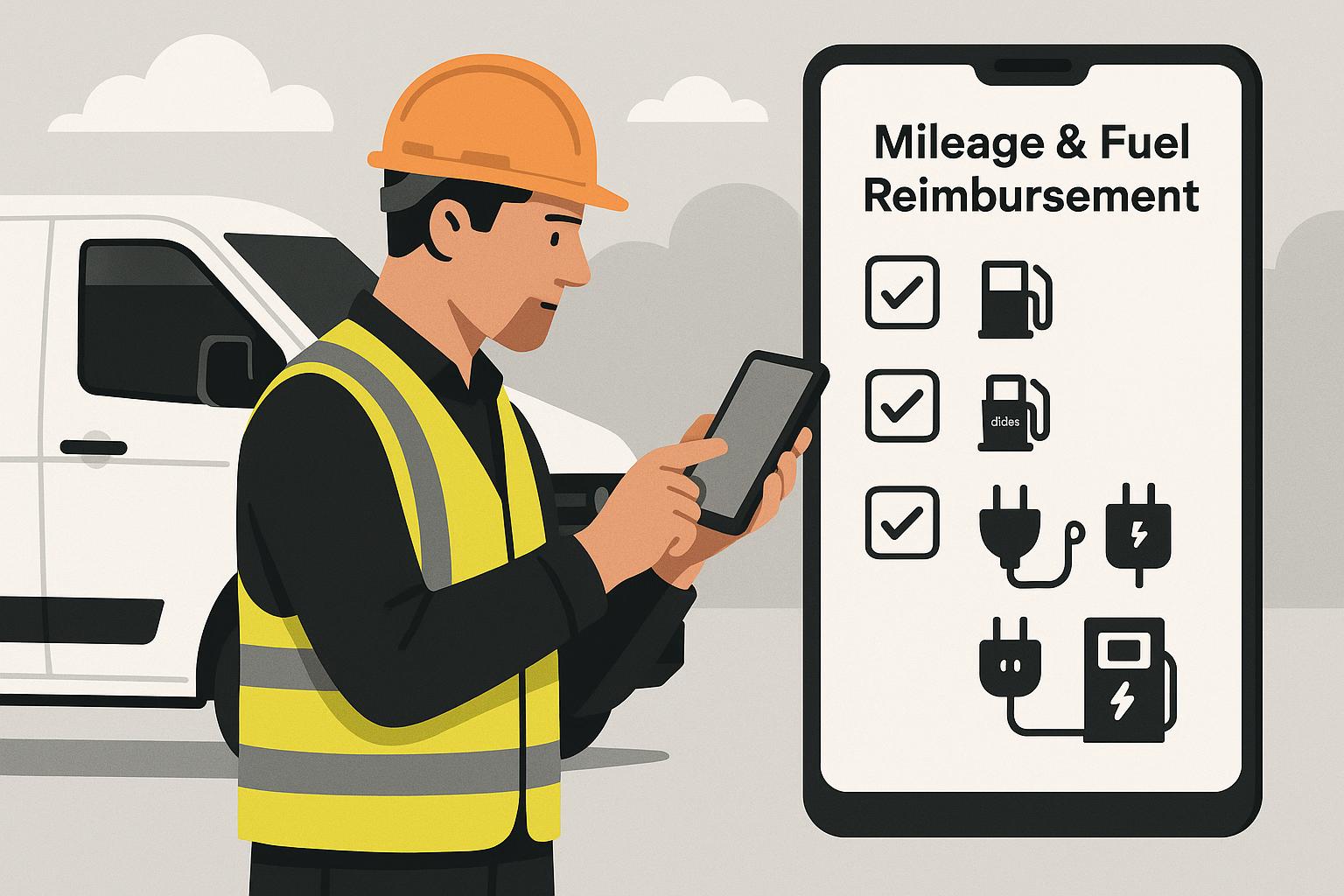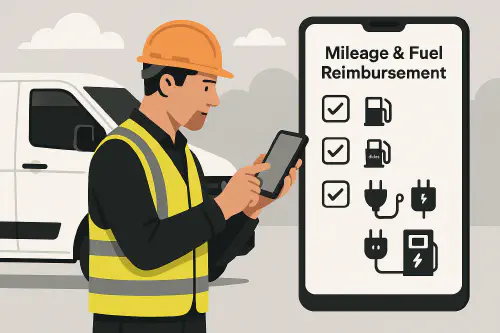
HMRC Advisory Fuel Rates made simple for construction firms: vans vs company cars, EV home vs public charging, and clean Xero/QuickBooks workflows
HMRC Advisory Fuel Rates made simple for construction firms: vans vs company cars, EV home vs public charging, and clean Xero/QuickBooks workflows
Category: Finance & Tax • Niche: mileage, AFR/AER, company cars vs vans, EVs, VAT, Xero, QuickBooks
Contents
- Quick answer
- AFR vs AER vs AMAP: what to use when
- EVs: home vs public charging rates
- Vans: why AFR does not apply
- Simple, compliant record‑keeping
- Xero workflow: reimburse and reconcile without mess
- QuickBooks workflow: AMAP and AFR handled correctly
- FAQ

UK foreman by a van checking mileage reimbursement on phone with petrol, diesel and EV charging icons
Quick answer
- Company cars use HMRC Advisory Fuel Rates (AFR). Fully electric company cars use Advisory Electricity Rates (AER).
- From 1 September 2025 the AER splits: 8p per mile for home charging; 14p per mile for public charging. HMRC reviews rates quarterly. See GOV.UK: Advisory fuel rates.
- Employees using their own vehicles claim HMRC mileage (AMAP): 45p/mile for the first 10,000 miles in the tax year, then 25p. See GOV.UK: Travel — mileage and fuel rates.
- AFR does not apply to vans. For company vans, repay private fuel or apply the van fuel benefit rules; for employee‑owned vans, use AMAP.
AFR vs AER vs AMAP: what to use when
- AMAP (Approved Mileage Allowance Payments)
- Use when a worker uses their own vehicle for business.
- Cars/vans: 45p per mile up to 10,000 miles, then 25p; motorcycles 24p; bikes 20p. Source: GOV.UK rates.
- AFR (Advisory Fuel Rates)
- Use to reimburse business fuel in company cars only (petrol/diesel/LPG/hybrid treated as petrol/diesel).
- Rates vary by engine size and are updated quarterly. Source: GOV.UK: Advisory fuel rates.
- AER (Advisory Electricity Rates)
- Use for fully electric company cars. From 1 September 2025: 8p/mile home charging, 14p/mile public charging. Source: GOV.UK: Advisory fuel rates.
EVs: home vs public charging rates
- Home charging AER: 8p/mile from 1 Sept 2025. Reimbursing an employee’s domestic electricity for charging a company car is not a taxable benefit if it only covers business use. HMRC guidance: EIM23900.
- Public charging AER: 14p/mile from 1 Sept 2025. You may reimburse above AER if you can evidence higher actual cost per mile (e.g., specific rapid charger tariffs). Source: GOV.UK: Advisory fuel rates.
Vans: why AFR does not apply
- AFR is for company cars only — not vans. HMRC confirms AFR “must not” be used for vans. Source: GOV.UK: Advisory fuel rates.
- Employee’s own van: use AMAP rates (same as cars) for business travel. Source: GOV.UK mileage rates.
- Company van fuel:
- Business fuel: reimburse actual business fuel cost (keep mileage and fuel receipts). If you pay more than cost, the excess is taxable/NICable. See HMRC booklet 480, Chapter 13: Taxable fuel for company cars and vans.
- Private fuel provided: a flat van fuel benefit charge applies unless the employee makes good all private fuel by 6 July after the tax year. 2025 to 2026 figures are on GOV.UK rates.
Simple, compliant record‑keeping
Keep this for each vehicle and month:
- Driver name, reg, fuel type, engine size, CO2 band if relevant.
- Odometer start/end, total miles, business miles, private miles.
- For EVs: whether miles were home or public charged.
- Receipts/statements covering VAT on fuel (if reclaiming).
- The AFR/AER period used.

Checklist for mileage and fuel reimbursement
Quick audit checklist
- Mileage logs tie to odometer photos once a month.
- Rates used match the quarter.
- If reclaiming VAT on fuel via AFR, there are VAT receipts covering at least the claim value.
- EV reimbursements for home electricity are treated as No VAT.
Xero workflow: reimburse and reconcile without mess
Use this if you run company cars or reimburse AFR/AER.
- Set up accounts and tracking
- Motor Expenses: Fuel (expense)
- Employee Recharges – Fuel (other income)
- Payroll Clearing (liability, if clearing through payroll)
- Tracking: Vehicle and/or Employee
- If using a fuel card
- Add the card as a bank account in Xero and reconcile spends to Motor Expenses: Fuel (20 percent VAT when you hold VAT invoices/statement). Attach statements and tag Vehicle.
- Company cars with private use — recharge private fuel at AFR
- Collect mileage monthly; compute private miles.
- Sales Invoice to employee: “Private fuel recharge – [Month]”
- Qty = private miles; Unit price = AFR pence/mile; VAT = Standard (output VAT due on private fuel recharges)
- Receive payment or post to Payroll Clearing and net off in payroll.
- Alternative: If not recharging, consider the VAT fuel scale charge method and journal the scale charge each VAT period. See HMRC’s scale charge tables.
- Reimbursing business mileage in a company car (AFR/AER)
- Supplier Bill or Xero Expenses claim per employee per month:
- Line: “Business mileage – [Month]”
- Qty = business miles; Unit price = AFR (or AER)
- VAT: 20 percent Standard for fuel AFR; No VAT for AER home‑electric reimbursements.
- Tips
- Lock the month after posting. Keep odometer photos. Store the HMRC rate snapshot with the files.
Related reading in the Academy:
- Geofencing timesheets on construction sites: auto clock in, stop buddy punching and stay compliant
- Stop chargebacks on site: photos, signatures and payment flows that protect your jobs
QuickBooks workflow: AMAP and AFR handled correctly
Two common cases:
A) Personal car used for business (AMAP)
- Create one Expense per claim period with two lines:
- “Mileage – Fuel element (AFR)”: Qty = miles; Rate = AFR; VAT = Standard. Attach fuel receipts covering the claim value.
- “Mileage – AMAP non‑fuel”: Qty = miles; Rate = AMAP minus AFR; VAT = No VAT.
- This splits out the VATable fuel element correctly and pays the worker the full AMAP rate.
B) Company car business mileage (AFR/AER)
- One Expense line: Qty = miles; Rate = AFR (or AER).
- VAT: 20 percent Standard for fuel AFR; No VAT for home‑electric AER claims. For public chargers paid by the employee, you can reimburse actuals with VAT if a VAT invoice is provided.
Controls
- Update AFR/AER quarterly in your Products/Services list.
- If reclaiming all input VAT on fuel with private use, post the VAT fuel scale charge each VAT period.
- For EVs, keep home vs public charging separate to apply the correct AER and VAT code.
FAQ
Do AFR apply to vans?
No. AFR are only for company cars. For employee‑owned vans use AMAP; for company vans reimburse actual business fuel and watch van benefit/fuel benefit rules. See GOV.UK AFR.
Can we pay above AER for public charging?
Yes, if you can evidence higher actual cost per mile. Keep charger invoices and a simple cost‑per‑mile calc. See GOV.UK AFR/AER.
Is reimbursing home electricity for a company EV a taxable benefit?
No, provided it relates only to charging the company car. HMRC EIM23900 confirms no taxable benefit or NICs.
Can we reclaim VAT on home electricity for EV mileage claims?
No. Home electricity is not a business supply to the company, so AER mileage reimbursements for home charging are No VAT.
Do hybrids use AER?
No. Hybrids are treated as petrol or diesel for AFR.
What if we provide all fuel on a company fuel card and reclaim the VAT?
Apply the VAT fuel scale charge each VAT period unless there’s no private use. Speak to your accountant about the right CO2 band and postings.
Call to action
Want to slash training times and increase revenue per Engineer? Join our Waitlist: https://trainar.ai/waitlist